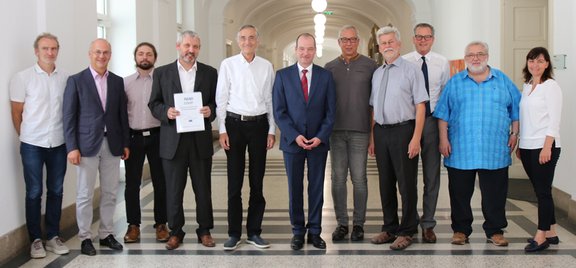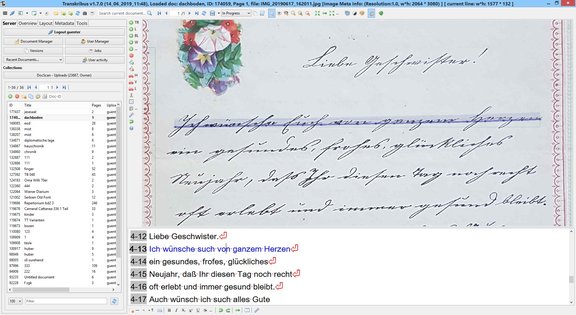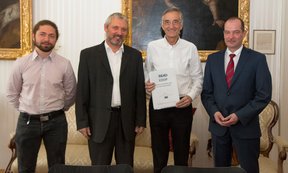The Raiffeisenverband Tirol was responsible for the transfer into a cooperative. READ-COOP is thus the first European cooperative of the Raiffeisenverband in Austria. The new European cooperative READ-COOP already has a central aspect of the platform in its name: cooperation. With the model of the European Cooperative, in short SCE for Societas Cooperative Europaea, the European Union offers excellent conditions that enable cooperation across national and professional borders. "It is a democratically organised organisation that is open to new members, who in turn become co-owners through the acquisition of shares. At the same time, an SCE offers the opportunity to do business and thus secure the future and further development of the Transkribus platform," explains Dr. Günter Mühlberger. He is head of the Group for Digitization and Electronic Archiving at the University of Innsbruck and, together with his team, has played a leading role in launching the Transkribus service platform. "The worldwide interest in the recognition of handwriting has encouraged us to transfer the project to a company. The foundation of a European Cooperative seemed to us to be the most suitable option. The development of the huge archive holdings can only be realized through a joint effort," Mühlberger explains. "The Raiffeisenverband provided us with very good advice and competent support in all areas during the start-up phase. We would particularly like to thank Dr. Daniel Wibmer from the Innovative Cooperatives Unit of the Raiffeisenverband Tirol and Prof. Markus Dellinger from the Raiffeisenverband Wien.

Interest from all over the world
Günter Mühlberger considers the fact that the platform and its capabilities have developed so excellently in recent years to be primarily due to the good cooperation. "From historians, computer scientists and persons from institutions such as libraries or archives to interested private individuals: They have all worked together to ensure that the self-learning system has developed rapidly and well at all levels. The more intensively the platform is used, the faster it 'learns'," says Mühlberger. The success also came as a surprise to the project managers at the University of Innsbruck. "When we started in 2016, one of our goals was that the handwriting of our great-grandmother could be read by the computer. We have now achieved this goal, and both the recognition of the handwriting and the analysis of the layout - such as the automatic recognition of lines - have improved dramatically. The colleagues from Rostock and Valencia, who are responsible for the development of the actual text recognition, were able to reduce the error rate from 15 percent to 3 percent. We now have almost 25,000 registered users, 300 of whom are active users per day. This is more than a tenfold increase within three years."
The success of the project can also be seen in the interest in READ-COOP: Together with the University of Innsbruck, the founding members will include the University of Greifswald, Rostock, Erlangen-Nuremberg, Edinburgh, the State Archives of Zurich, the National Archives of Finland, the Archives of the Diocese of Passau, the British Library, but also the Association of Computer Genealogy Germany.
The potential in the automated recognition of historical writings is enormous: "To date, a maximum of one to two percent of the archive holdings in Europe and worldwide have been digitized. By making these holdings accessible through automated text recognition, these holdings will now be accessible not only to scholars but also to interested family researchers," says Mühlberger. Two pilot projects, in which the recognition of large archive holdings from Finland and the Netherlands will be tested, are already in preparation and will be carried out by READ-COOP in 2019 and 2020.

Project: KaTI-digital Tirol
Two pilot projects testing the identification of large archival collections from Finland and the Netherlands are already in preparation and will be realised by READ-COOP in 2019 and 2020. READ-COOP SCE is also already part of a project that has received a grant within the framework of the lighthouse projects in the field of digitisation of the Land Tyrol. "KAtaster TIrol digital" is the title of the project under the direction of Prof. Kurt Scharr from the Institute for Historical Sciences and European Ethnology. KaTi-digital deals with the Franziscean Cadastre of Tyrol and aims at digitisation, handwriting recognition and processing for the public. The Franziscean Cadastre was the first complete Austrian real estate cadastre and was created between 1810 and 1870. It is of great historical importance, as it recorded the former national territory in detail geodetically and depicts ownership conditions. Within the framework of the project, the records for Tyrol are to be processed and made publicly accessible. KaTi-digital runs until the end of 2020, the Tiroler Landesarchiv and the Austrian Bundesamt für Eich- und Vermessungswesen are also involved.

